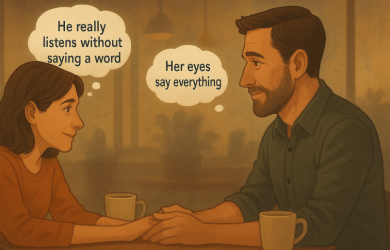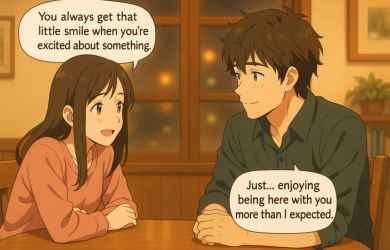What Your Body Language Says About Your Relationship

Unlock Daily 30-Sec Tips for a Happier Relationship
👉 Subscribe FREEKey Takeaways
Marriage.com AI Quick Summary
Our communication is made up of both verbal and non-verbal signals. From our facial expressions to how we position our body, the things we don’t say still send a message and impact how we relate to others.
When we familiarize ourselves with body language, we become better at deciphering what others communicate without using words. Awareness of body language signs also improves our communication skills.
Through the command of our body language signs, we are controlling what message we are sending out and decreasing the risk of communicating something we never wanted to “say.”
Before we move on to explaining examples of body language signs, let’s define what body language is first.
What is body language?
Body language refers to the non-verbal part of communication. A substantial portion of communication consists of non-verbal signals, including body language. According to studies, that part is 60-65% of our daily interactions.
Other types of non-verbal communication include facial expressions, appearance, touch, eye contact, personal space, gestures, paralinguistics like the tone of voice, and artifacts such as objects and images.
Reading body language starts with comprehending the meaning of the body language signs. Although the meaning of body language signals can differ depending on the situation and people involved, some signs are more straightforward and apparent in its meaning.
Positive body language signs
1. Smiling
We have 43 muscles on our face, so it’s not surprising that the face is our most revealing body area. Think about how much a person can convey with their facial expression.
If someone tells you they are fine, yet their face doesn’t show the appropriate emotion, you won’t believe what they are saying.
Also, we make the judgment on their emotional status and personality impossibly quickly. Data indicated 100 ms exposure to a face is sufficient for people to make various personal judgments such as trustworthiness, competence, and aggressiveness.
Interestingly, they also found that the facial expression involving a slight rise of the eyebrows and a slight smile is most correlated to friendliness and confidence. Therefore, smiling persists as one of the most important positive body language signs.
2. Mimicking each other’s moves
Body language of couples who are happily in love discovers they tend to move, smile, and speak similarly.
Spending a lot of time together and finding someone attractive prompts us to, mostly subconsciously, mimic their mannerisms. Mirroring each other’s moves is considered the body language of couples in love.
3. Synchronized walking
Couples’ body language reveals how much they are intimate and connected through signs such as how in tune they are with each other when walking, for instance.
The more they are aware and connected to their partner’s non-verbal signals, the more they can match their walking style. Therefore, we can argue that the level of closeness will impact the synchronicity of partners’ actions.
4. Body angled toward each other
There is one body language secret anyone looking to know if a person likes them should know. When we find someone appealing or stimulating, our body naturally angles towards them. We are not even aware of when this happens.
Therefore, you can use this body language sign to check how the other person feels about you. Does their body or tips of legs point towards you? Keep an eye out for this body language of love.
5. Spontaneous and frequent touches
When we feel attracted to someone, we want to touch them almost instinctively. Whether it is taking the “evident” dust bunnies off their shirt, a gentle stroke on the arm, or a spontaneous touch while talking, this body language sign reveals a desire for intimacy. When there is emotional closeness , touching is as natural as breathing.
6. Leaning toward each other
If you are looking to understand relationship body language, keep an eye out for people inclining themselves to be more near the other person. Are they leaning in while the other is talking? Leaning the upper body towards someone and lining our face with theirs is a sign of genuine interest.
Furthermore, leaning your head on someone’s shoulder as a relationship, body language translates into trust and closeness. This means you are comfortable being physically close to them, and it speaks to intimacy in the relationship.
7. Gazing into each other’s eyes
There is a reason people say “eyes are a mirror of the soul.” So much can be encompassed in one look. Eye contact love signals can carry in them an entire conversation.
Therefore, when someone is looking at you often or staring into your eyes a bit longer than usual, you can be pretty sure they are interested in you. Furthermore, couples who are intimate and in love can exchange full sentences with just one look. They automatically look at each other when something is happening to check for their loved one’s reactions.
Therefore, eye contact love signals symbolize trust, familiarity, and mutual understanding that doesn’t need words.
8. Open palms during a conversation
Our posture and gestures change depending on our impression of the person and our conversations since our body reflect how we feel.
Hence, when we are interested in what someone is telling us and willing to listen to the person, our hands usually display it through gestures of openness. Exposed palms are usually an indicator of an open mind and focused attention on a person.
9. Protective gestures
Have you noticed a partner put their arm around you in public to protect you? Perhaps they take your hand instinctively when crossing the street? Do they notice if someone is making you uncomfortable and join the conversation to protect you?
Actions like these show they want to shield you as we all do when we care for someone. They instinctively need to make sure you are safe.
According to Grady Shumway, a licensed mental health counselor:
Positive gestures in a relationship include acts of kindness, appreciation, and affection that demonstrate care and support for your partner.
These gestures can range from simple actions like offering compliments, expressing gratitude, and showing affection through physical touch to more significant efforts such as thoughtful surprises, acts of service, and actively listening to your partner’s needs.
By consistently making these gestures, you cultivate a sense of love, connection, and emotional intimacy in the relationship.
10. Special rituals unique to you two
Do you have a special way you high-five each other, wink, or say goodbye to each other? Just like internal jokes, secret handshakes, and special rituals speak to the level of your familiarity. When we know each other well and feel close, it shows in our behavior.
Negative body language signs
1. Irregular blinking
Although blinking is natural, and we do it all the time, its intensity is worth noting. More frequent blinking is indicative of discomfort or distress.
Furthermore, data shows that infrequent blinking indicates that a person is intentionally trying to control their eye movements. In either case, irregular blinking can signal someone is not feeling comfortable or pleased to be in that situation or with that person.
2. Pat on the back
A pat on the back per se doesn’t have to be a negative sign. However, if you are in a relationship, it can indicate a lack of intimacy. If you need reassurance and support and your partner chooses a pat over a gentle embrace, it could indicate loss of connection. It is not a death sentence for the relationship, but it’s worth looking into.
3. Closed body posture
When trying to understand body language and relationships, observe people’s posture. A closed posture involving hunching forward and hiding the trunk of the body can indicate unfriendliness and anxiety.
4. Furrowed brows
Dr. Gottman’s research identifies contempt as one of the leading causes of divorce. One of the ways our body reveals criticism are furrowed brows. If people are not confused by what is being said, furrowed brows can indicate disagreement, antipathy, anger, or aggression.
This can be a manifestation of an intense conversation and a caution to be careful of potential escalations.
5. Hands resting on hips
Have you ever seen people talking and assuming a position with hands on their hips? If you have, most likely, you quickly thought there might be an argument happening there. That is because standing with hands placed on the hips can signify being in control or being ready.
This body sign translates into dominance and being bossy. Possibly, it can also be interpreted as a sign of aggression.
6. Crossed arms
When we need to feel more protected, we make a body block. Crossed arms during a conversation can signify a need to create a wall between us and the other person and their words.
Arms crossed on the chest signify a need to decrease vulnerability we might feel at the moment. It can also indicate feeling upset, angry, or hurt.
Also watch: Psychology tricks to read anyone like a book
7. Hands-on the forehead
When a person puts their hands on their forehead, they are usually hitting a wall of some kind. Possibly they are tired of trying to get their point across and frustrated for not feeling heard.
If you notice your partner doing it often, you want to check-in and be more attentive to what they are trying to communicate.
8. Leaning away from each other
Body language of couples in love usually shows their bodies angling and leading towards each other, and following the same logic, turning away from each other displays a need for distance.
It could be momentary or more notable; however, turning away from someone or leaning further away can indicate antipathy or discomfort.
9. Looking away
Although it can be tempting to look down or to the side when someone speaks to us, avoiding eye contact can translate into disinterest. According to research, social anxiety is related to avoiding or turning away from eye contact.
However, it is mostly interpreted as disinterest in the conversation. If possible, practice looking into other’s eyes at least 60% of the time. More than that might seem as starting, and less than that as not being involved.
10. Pulling away from physical contact
When in love, people seek to touch each other more often. If instead of brushing off dust bunnies or putting a stray hair string behind their ear, a partner chooses to simply inform their loved one of a messy look, it could be a red flag.
Especially when it is continuous and joined by another negative body language such as turning away to the other side in bed, more formal and quick kisses, or letting go of a hand when attempting hand-holding.
How to send more friendly non-verbal signals?
If you wish to make sure you are not pushing anyone away subconsciously, start by paying more attention to your body language. How do you sit, establish eye-contact, position yourself while communicating with someone, and what is your facial expression at the moment?
Controlling non-verbal communication takes practice.
Studies have shown a connection between open posture and one’s romantic desirability. Open body posture exhorts this effect through the perception of dominance and openness of people assuming this posture.
Therefore, if you look to increase your odds in dating, you could observe and assume a more open body posture.
Nonverbal communication plays an important role in conveying information to others and how they interpret our actions and judge our character.
Smile more, keep your hands open and out of your pockets, establish more eye contact, and avoid some of the negative body gestures to seem more friendly and improve your interactions with others.
Always consider the context
While much of the body language can be intuitively understood, always be careful and consider the context. Don’t assume to know what something means for sure or take it to mean always the same thing.
While the expressions, appearance, and tone of voice can tell you a lot about what the person is trying to say, always consider what they tell you when interpreting the meaning of their message.
Furthermore, you know your partner and people close to you better than anyone else. While you might observe some of the negative non-verbal signs, the safest way to interpret them is by discussing them with the person.
Being mindful of body signals and potential red flags should not be equivalent to jumping to conclusions.
Instead, take time to ask the person and clarify any body language that might be confusing you. Remember to include both ends of the spectrum in your search for meaning – verbal and non-verbal.
 Tips
Tips
Write your tip or submit a video tip
All tips are reviewed before the publishing.
Share this article on
Want to have a happier, healthier marriage?
If you feel disconnected or frustrated about the state of your marriage but want to avoid separation and/or divorce, the marriage.com course meant for married couples is an excellent resource to help you overcome the most challenging aspects of being married.
Recent Articles
Related Quizzes
Unlock Daily 30-Sec Tips for a Happier, Healthier Relationship
👉 Subscribe FREE on YouTube We'd love your feedback!
We'd love your feedback!
 Expert Q&A
Expert Q&A
Ask your question related to this topic & get the support you deserve from experts.





















 Thanks for your feedback!
Thanks for your feedback!